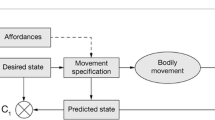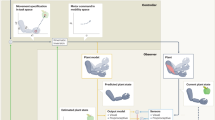Abstract
I argue against a growing radical trend in current theoretical cognitive science that moves from the premises of embedded cognition, embodied cognition, dynamical systems theory and/or situated robotics to conclusions either to the effect that the mind is not in the brain or that cognition does not require representation, or both. I unearth the considerations at the foundation of this view: Haugeland's bandwidth-component argument to the effect that the brain is not a component in cognitive activity, and arguments inspired by dynamical systems theory and situated robotics to the effect that cognitive activity does not involve representations. Both of these strands depend not only on a shift of emphasis from higher cognitive functions to things like sensorimotor processes, but also depend on a certain understanding of how sensorimotor processes are implemented - as closed-loop control systems. I describe a much more sophisticated model of sensorimotor processing that is not only more powerful and robust than simple closed-loop control, but for which there is great evidence that it is implemented in the nervous system. The is the emulation theory of representation, according to which the brain constructs inner dynamical models, or emulators, of the body and environment which are used in parallel with the body and environment to enhance motor control and perception and to provide faster feedback during motor processes, and can be run off-line to produce imagery and evaluate sensorimotor counterfactuals. I then show that the emulation framework is immune to the radical arguments, and makes apparent why the brain is a component in the cognitive activity, and exactly what the representations are in sensorimotor control.
Similar content being viewed by others
References
Ashby, W.R.: 1952, Design for a Brain, Chapman and Hall, London.
Behrmann, M.: 2000, ‘The Mind's Eye Mapped onto the Brain's Matter’, Trends in Psychological Science 9(2), 50-54.
Blakemore, S.J., Goodbody, S.J. and Wolpert, D.M.: 1998, ‘Predicting the Consequences of Our Own Actions: The Role of Sensorimotor Context Estimation’, The Journal of Neuroscience 18(18), 7511-7518.
Brooks, R.: 1991, ‘Intelligence Without Representation’, Artificial Intelligence 47, 139-159.
Chen, W., Kato, T., Zhu, X.H., Ogawa, S., Tank, D.W. and Ugurbil, K.: 1998, ‘Human Primary Visual Cortex and Lateral Geniculate Nucleus Activation during Visual Imagery’, Neuroreport 9(16), 3669-3674.
Clark, A.: 1989, Microcognition, MIT Press, Cambridge, MA.
Denier van der Gon, J.J.: 1988, ‘Motor Control: Aspects of Its Organization, Control Signals and Properties’, in Wallinga et al. (eds), Proceedings of the 7th Congress of the International Electrophysiological Society.
Desmurget, M. and Grafton, S.: 2000, ‘Forward Modeling Allows Feedback control for Fast Reaching Movements’, Trends in Cognitive Sciences 4(11), 423-431.
Farah, M., Soso, M.J. and Dasheiff, R.M.: 1992, ‘Visual Angle of the Mind's Eye Before and after Unilateral Occipital Lobectomy’, Journal of Experimental Psychology: Human Perception and Performance 18(1), 241-246.
Gelb, A.: 1974, Applied Optimal Estimation, MIT Press, Cambridge, MA.
Grush, R.: 1995, Emulation and Cognition. PhD Dissertation in Philosophy and Cognitive Science, UC San Diego.
Grush, R.: 1997, ‘Yet Another Design for a Brain?’ [Book review of Robert Port and Timothy van Gelder (eds, 1995) Mind as Motion: Explorations in the Dynamics of Cognition. Cambridge, MA, MIT Press] Philosophical Psychology 10(2), 233-242.
Grush, R.: 2002a, An Introduction to the Main Principles of Emulation: Motor Control, Imagery, and Perception. UCSD Philosophy Department Tech Report 2002-01.
Grush, R.: in preparation, The Machinery of Mindedness.
Haugeland, J.: 1991, ‘Representational Genera’, in W. Ramsey, S. Stich and J. McCelland (eds), Philosophy and Connectionist Theory, Lawrence Earlebaum, Hillsdale. Reprinted in Haugeland (1998).
Haugeland, J.: 1995, ‘Mind Embedded and Embodied’, in L. Haaparanta and S. Heinäma (eds), Mind and Cognition: Philosophical Perspectives on Cognitive Science and Artificial Intelligence. Acta Philosophica Fennica 58, 233-267. Reprinted in Haugeland (1998).
Haugeland, J.: 1998, Having Thought, Harvard University Press, Cambridge MA.
Haykin, S. (ed.): 2001, Kalman Filtering and Neural Networks, Wiley, New York.
Houk, J.C., Singh, S.P., Fischer, C. and Barto, A.: 1990, ‘An Adaptive Sensorimotor Network Inspired by the Anatomy And Physiology of the Cerebellum’, in W.T. Miller, R.S. Sutton and P.J. Werbos (eds), Neural Networks for Control, MIT Press, Cambridge, MA.
Hutchins, E.: 1995, Cognition in the Wild, MIT Press, Cambridge, MA.
Ito, M.: 1970, ‘Neurophysiological Aspects of the Cerebellar Motor Control System’, International Journal of Neurology 7, 162-176.
Ito, M.: 1984, The Cerebellum and Neural Control, Raven Press, New York.
Jeannerod, M.: 2001, ‘Neural Simulation of Action: A Unifying Mechanism for Motor Cognition’, NeuroImage 14, S103-S109.
Johnson, S.H.: 2000, ‘Thinking Ahead: The Case for Motor Imagery in Prospective Judgements of Prehension’, Cognition 74, 33-70.
Kalman, R.E.: 1960, ‘A New Approach to Linear Filtering and Prediction Problems’, Journal of Basic Engineering 82(d), 35–45.
Kalman, R. and Bucy, R.S.: 1961, ‘New Results in Linear Filtering and Prediction Theory’, Journal of Basic Engineering 83(d), 95–108.
Kawato, M.: 1999, ‘Internal Models for Motor Control and Trajectory Planning’, Current Opinion in Neurobiology 9, 718–727.
Kosslyn, S.M., Alpert, N.M., Thompson, W.L., Maljkovic, V., Weise, S.B., Chabris, C.F., Hamilton, S.E., Rauch, S.L. and Buonanno, F.S.: 1993, ‘Visual-mental Imagery Activates Topographically-Organized Visual Cortex: PET Investigations’, Journal of Cognitive Neuroscience 5, 263–287.
Kosslyn, S.M. and Sussman, A.L.: 1995, ‘Roles of Imagery in Perception: or, There Is No Such Thing as Immaculate Perception’, in M.S. Gazzaniga (ed.), The Cognitive Neurosciences, MIT Press, Cambridge, MA.
Kosslyn, S.M., Thompson, W.L., Kim, I.J. and Alpert, N.M.: 1995, ‘Topographical Representations of Mental Images in Primary Visual Cortex’, Nature 378: 496–498.
Krakauer, J.W., Ghilardi, M-F. and Ghez, C.: 1999, ‘Independent learning of internal models for kinematic and dynamic control of reaching’, Nature Neuroscience 2(11), 1026–1031.
Mehta, B. and Schaal, S.: 2002, ‘Forward Models in Visuomotor Control’, The Journal of Neurophysiology 88(2), 942–953.
Mel, B.W.: 1988, ‘MURPHY: A Robot that Learns by Doing’, in Neural Information Processing Systems, American Institute of Physics, New York, pp. 544–553.
Stein, L.: 1991, Imagination and Situated Cognition. MIT Artificial Intelligence Laboratory Memo No. 1277.
van der Meulen, J.H.P., Gooskens, R.H.J.M., Dennier van der Gon, J.J., Gielen, C.C.A.M. and Wilhelm, K.: 1990, ‘Mechanisms Underlying Accuracy in Fast Goal-Directed Arm Movements in Man’, Journal of Motor Behavior 22(1), 67–84.
van Gelder, T.: 1995, ‘What Might Cognition Be If Not Computation?’ Journal of Philosophy 92(7), 345–381.
van Gelder, T.: 1996, ‘Dynamics and Cognition’, in J. Haugeland (ed.), Mind Design II, MIT Press, Cambridge, MA.
van Gelder, T. and Port, R.: 1995, ‘It's about Time’, Editors' introduction to R. Port and T. van Gelder (eds), Mind as Motion: Explorations in the Dynamics of Cognition MIT Press, Cambridge, MA.
Wexler, M., Kosslyn, S.M. and Berthoz, A.: 1998, ‘Motor Processes in Mental Rotation’, Cognition 68, 77–94.
Wolpert, D.M., Ghahramani, Z. and Jordan, M.I.: 1995, ‘An Internal Model for Sensorimotor Integration’, Science 269, 1880–1882.
Wolpert, D.M., Ghahramani, Z. and Flanagan, J.R.: 2001, ‘Perspectives and Problems in Motor Learning’, Trends in Cognitive Sciences 5(11), 487–494.
Author information
Authors and Affiliations
Rights and permissions
About this article
Cite this article
Grush, R. In Defense of Some `Cartesian' Assumptions Concerning the Brain and Its Operation. Biology & Philosophy 18, 53–93 (2003). https://doi.org/10.1023/A:1023344808741
Issue Date:
DOI: https://doi.org/10.1023/A:1023344808741




